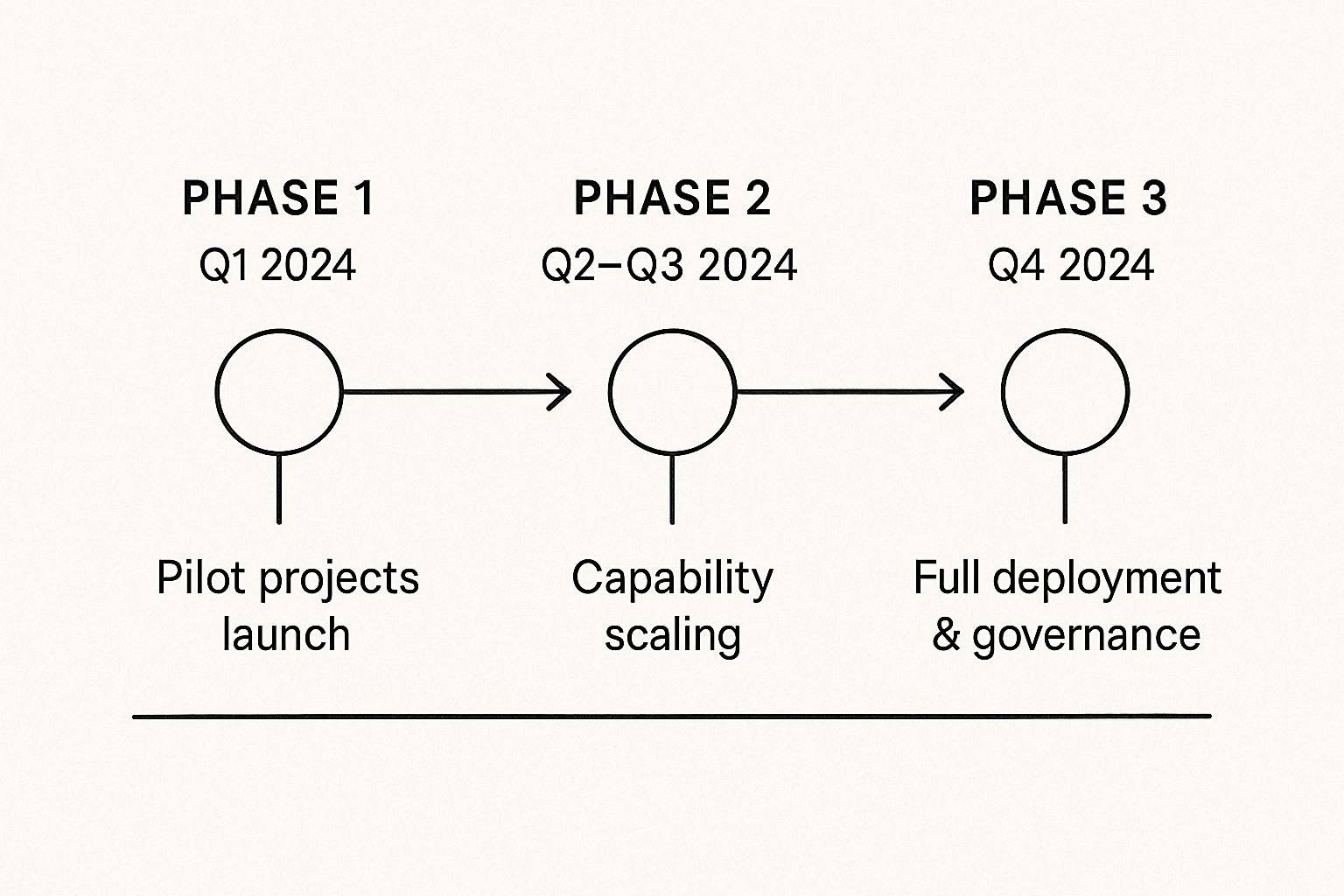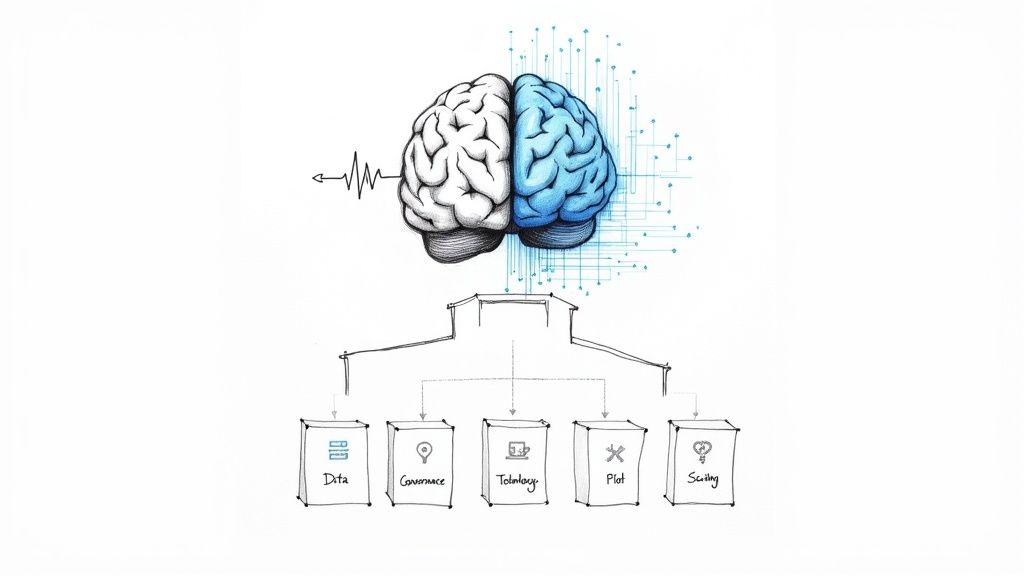Build a Powerful AI Strategy Roadmap
Learn to build an actionable AI strategy roadmap. Our guide covers aligning AI with business goals, prioritizing use cases, and driving measurable growth.

Think of an AI strategy roadmap as your company's master plan for artificial intelligence. It's a high-level guide that lays out exactly how your business will use AI to hit its most important long-term goals. This isn't just a document for the tech team; it’s a strategic compass connecting every AI project directly to real, measurable business results.
Why You Need an AI Roadmap Today
In today's fast-moving market, letting AI initiatives pop up as a bunch of disconnected side projects is a surefire way to fall behind. A formal AI strategy roadmap is what turns artificial intelligence from an interesting concept into a real engine for growth. It provides much-needed clarity, direction, and a structured path forward.
Companies that are winning with AI use these roadmaps to make sure their technology investments line up perfectly with their core business objectives. This guarantees every AI project delivers a clear, measurable return. It's about moving past abstract ideas and creating a concrete plan that connects your vision to what actually gets done.
From Buzzword to Business Impact
A solid roadmap gives you the framework to manage resources effectively, anticipate potential risks, and draw a straight line from investment to impact. It forces your organization to stop and answer the tough questions before a single dollar is spent on development:
- What specific business problems are we actually trying to solve with this?
- What does success look like, and how will we measure it?
- Do we have the right data, skills, and tools in-house to make this work?
The urgency is real. By 2025, the global AI landscape has exploded, with 78% of organizations worldwide now using at least one AI tool. That’s a massive jump from just 55% in 2024. This rapid adoption, as we explored in our AI adoption guide, shows why having a structured plan is no longer optional. You can dig into these trends in the 2025 Stanford HAI AI Index Report.
A roadmap isn’t about perfectly predicting the future. It’s about building an agile framework that helps your organization adapt, learn, and intelligently scale its AI capabilities as you go.
Before we dive into the steps, let's quickly break down the core components of an effective AI roadmap. Think of these as the essential pillars of your plan.
Core Components of an Effective AI Roadmap
| Component | Key Objective |
|---|---|
| Business Alignment | Ensure every AI initiative directly supports a core business goal or solves a key problem. |
| Readiness Assessment | Honestly evaluate your current data, technology, and talent capabilities. |
| Use Case Prioritization | Identify and rank potential AI projects based on impact, feasibility, and ROI. |
| Execution Plan | Define clear timelines, milestones, resource allocation, and key performance indicators (KPIs). |
| Governance & Ethics | Establish clear guidelines for responsible AI use, data privacy, and risk management. |
Understanding these components is the first step. To truly appreciate what a roadmap can do, it's helpful to see the bigger picture of Leveraging AI Automation for Business Success. Ultimately, this plan will guide your entire journey, ensuring your AI efforts are both purposeful and powerful. Methods like AI co creation and expert AI strategy consulting can help you get started on the right foot, turning a complex challenge into a clear opportunity.
Weaving Your AI Vision into Your Business Goals

Any successful AI strategy roadmap worth its salt doesn't kick off with a deep dive into technology. It starts with a far more basic, and crucial, question: "What business problem are we actually trying to solve?" Time and again, I've seen AI projects fail because they were disconnected from any real, tangible business value.
Chasing the newest AI trend without a clear purpose is a recipe for disaster. It's like buying a high-performance engine with no car to put it in. The real goal is to make sure every single AI initiative directly answers a strategic need—whether that's making operations smoother, driving more revenue, or giving customers an experience they'll remember. Nailing this alignment from day one is what separates successful projects from costly experiments.
From Vague Goals to Solvable Problems
The first real task is to take those high-level ambitions and break them down into specific, well-defined challenges that AI is uniquely suited to tackle. Simply saying, "We want to improve customer support," is far too broad to be actionable. You have to get your hands dirty and dig deeper.
A much better way forward is to pinpoint the root cause of a business headache. Let's take that "improve customer support" goal. When you unpack it, you might find several concrete problems hiding underneath:
- The Problem: Our support team is bogged down, spending 60% of its time answering the same five basic questions. This creates long waits for customers with genuinely complex issues.
- The Problem: We're completely blind to which customers are at high risk of churning until they’ve already walked out the door.
- The Problem: Our agents don't have a customer's full history at their fingertips, leading to frustrating, repetitive conversations.
Suddenly, you're not just talking about a vague goal. Each of these specific problems points toward a potential AI solution—a chatbot for common questions, a predictive model for churn, or an AI-powered knowledge base for your agents. This is how you transform wishful thinking into a pipeline of high-impact projects.
Getting Leadership on Board and Building Your Crew
Once you have clearly defined problems, getting executive buy-in becomes a whole lot easier. You're no longer asking for a blank check for "an AI thing." Instead, you're presenting a solid business case to solve a measurable problem that directly affects the bottom line. Your pitch should be all about outcomes, not algorithms.
Executive sponsorship is non-negotiable. It gives you the top-down support needed to get resources, cut through organizational red tape, and champion the vision when you inevitably hit a bump in the road. Without it, even the best AI projects tend to fizzle out.
With leadership in your corner, your next move is to assemble the right team. An AI project can't just be an IT initiative. You absolutely need a cross-functional group that brings different perspectives to the table.
Your A-team should have people from:
- Business Leadership: To ensure the project stays true to the company's strategic goals.
- IT and Data Science: The technical wizards who can assess what's possible and build it.
- Frontline Operations: The folks on the ground who can give you priceless insights into the real-world problems you're solving.
- Finance: To keep an eye on the budget and help you measure the return on investment.
This kind of collaboration ensures that whatever you build is not only technically solid but also practical, usable, and actually adopted by the people it's meant to help.
Adopting a Framework That Works
To hold all these moving parts together, you need a structured game plan. A well-designed AI strategy framework acts as the scaffolding for your roadmap, guiding you from that initial brainstorming session all the way through to execution. It brings consistency to the process, clarifies who does what, and keeps everyone laser-focused on the business goals you set out to achieve. Think of it as the blueprint for your entire AI journey—it will help you navigate the complexities and make smart, informed decisions at every turn.
Finding Your High-Impact AI Opportunities

Now that you've anchored your vision in clear business goals, it’s time to hunt for the most promising AI opportunities. This part of building your AI strategy roadmap is all about looking inward and honestly assessing where you are right now. You can't build a skyscraper on a weak foundation, and the same principle absolutely applies to AI.
Gauging Your AI Readiness
Before you get carried away with exciting, complex projects, you have to get a firm grasp of your starting point. This means taking stock of your organization's readiness in a few critical areas. Trust me, investing in a sophisticated AI model before your data infrastructure is ready is a fast track to wasted time and money.
This evaluation doesn’t need to be a massive, multi-month audit. The goal is a practical snapshot of where you stand today.
Focus your assessment on these key areas:
- Data Infrastructure: Is your data easy to get to? Is it clean and organized? An AI model is only as good as the data it’s fed, so this is non-negotiable.
- Technical Skills: Look at your team. Do you have people with real-world experience in data science, machine learning, or engineering? Be honest about the skills you have versus the skills you might need to hire or train for.
- Organizational Culture: Is your company genuinely open to experimenting and letting data guide decisions? A culture that embraces change is just as important as technical skill for long-term success.
This quick self-assessment acts as a realistic filter, helping you see what's possible in the short term and what will require more foundational work first.
Brainstorming and Identifying Use Cases
With a clear picture of your capabilities, the fun part begins: generating ideas. At this stage, it's all about quantity over quality. Get your cross-functional teams in a room (or a virtual one) and let the ideas fly. Encourage everyone to think about how AI could solve the business problems you identified earlier.
To get the creative juices flowing, think about different categories of AI solutions. Looking at real-world use cases from other companies is a great way to make the conversation less abstract and more about concrete possibilities.
For instance, a logistics company might come up with ideas like:
- An AI system to optimize delivery routes on the fly.
- A predictive model to tell them when trucks will need maintenance before they break down.
- A tool that uses natural language processing to analyze thousands of customer feedback surveys in minutes.
Using a dedicated AI Strategy consulting tool can be a game-changer here. It helps you quickly discover relevant use cases and see how they might fit your specific business, saving you from countless hours of manual research.
Prioritizing Your AI Initiatives
You’ll probably end up with a long list of fantastic ideas. The real challenge is whittling that list down to a handful of high-impact projects that will deliver the most bang for your buck. When you're trying to figure out where to start, it's essential to have solid strategies for managing competing priorities so you can keep your team focused on what truly matters.
A simple scoring model is an incredibly powerful tool for this. It takes the guesswork out of the decision-making process and gets everyone aligned on a clear set of priorities.
Don't let the "cool factor" of a technology drive your decisions. The best AI projects are often the ones that solve a boring, repetitive, and expensive business problem with an elegant and simple solution.
Create a scorecard and have your team rate each potential project on a scale of 1 to 5 across these criteria:
| Prioritization Criteria | Description |
|---|---|
| Business Impact (ROI) | How much will this project move the needle on revenue, cost savings, or customer happiness? |
| Technical Feasibility | Based on your readiness check, how hard will this be to build with the data and skills you have right now? |
| Strategic Alignment | How well does this project fit with your core business goals for the next 1-3 years? |
| Time to Value | How fast can you get a minimum viable product (MVP) out the door and start seeing results? |
Once you've scored each idea, the projects with the highest totals are your top contenders. This structured approach, a cornerstone of any good AI strategy framework, turns a vague wish list into a concrete, prioritized action plan. This shortlist is what you'll use to build out the next phase of your roadmap: the execution plan.
Weaving Your Vision Into an Actionable Roadmap
Alright, you've pinpointed the high-impact opportunities. Now comes the real work: turning that strategic vision into a concrete, actionable plan. This is where your AI strategy roadmap comes to life. Think of it as the master blueprint that details the what, when, and how of your entire AI journey, giving everyone a clear timeline and a shared set of expectations.
From my experience, the most effective way to tackle this is to think in phases. A multi-year timeline, broken into manageable stages, lets you build momentum with early wins while setting the stage for bigger, more ambitious goals down the road.
This phased approach isn't just about organizing tasks; it's a strategic way to de-risk your investment. The lessons you learn from small, controlled experiments become the foundation for your larger, more significant projects.

Let's break down what this looks like in practice.
Phase 1: Quick Wins and Pilot Projects (The First 6-12 Months)
The first year is all about experimentation and learning. The name of the game is launching small-scale pilot projects to test your best ideas in a controlled setting. These are your "quick wins"—projects designed to deliver real, measurable value fast. More importantly, they build confidence and get people excited about what's possible.
For instance, a marketing team could pilot a simple AI tool to automate A/B testing for a specific email campaign. The scope is tight, the success metric is crystal clear (like a 15% lift in click-through rates), and you can show off the results in just one quarter. A success story like that is pure gold for getting broader buy-in.
Phase 2: Scaling and Building Capability (Months 12-24)
With a few successful pilots under your belt, it's time to scale what works. This phase is all about expanding those winning projects to more teams, refining the tech behind them, and investing in the skills and infrastructure needed to support wider adoption.
This is also when you have to get serious about building a solid data foundation and formalizing your AI governance. If that marketing pilot was a hit, this phase is when you’d integrate the tool with your main CRM, create documentation, and train the entire department on how to use it.
Phase 3: Deep Integration and Transformation (24 Months and Beyond)
The final phase is where AI stops being a "project" and becomes part of your company's DNA. The focus shifts from one-off initiatives to enterprise-wide platforms that can fundamentally change how you operate. These are the big, complex bets that deliver truly game-changing results.
This long-term vision requires serious investment in people and processes, not just tech. It's a global shift. We're seeing governments make huge commitments to drive this kind of change. Canada has pledged $2.4 billion, China is backing a $47.5 billion semiconductor fund, and India has allocated $1.25 billion to AI initiatives. These funds aren't just for R&D; they're for transforming the workforce and establishing ethical frameworks. It's worth exploring these global AI investment trends to grasp the scale of this movement.
To give you a clearer picture, here’s how a phased roadmap might look for a manufacturing company.
AI Roadmap Phasing Example
This table illustrates how a company could progress from small, targeted tests to a fully integrated AI ecosystem over three years.
| Phase | Timeline | Focus Area | Example Initiative |
|---|---|---|---|
| Phase 1: Pilot | 0-12 Months | Operational Efficiency | Pilot a predictive maintenance sensor on one critical assembly line to reduce downtime. |
| Phase 2: Scale | 12-24 Months | Process Optimization | Roll out predictive maintenance across all assembly lines; integrate data into the central ERP system. |
| Phase 3: Transform | 24+ Months | Supply Chain & Product | Develop a "digital twin" of the entire factory for full-scale simulation and optimization. |
Each phase builds directly on the successes and learnings of the last, creating a logical and increasingly impactful progression.
Defining Your Milestones and Metrics
For every phase, you need to set unambiguous milestones and key performance indicators (KPIs). Vague goals like "improve efficiency" just won't cut it. You need specific, measurable targets that tell you if you're actually winning.
A milestone without a metric is just a wish. Your KPIs are what make your roadmap accountable and ensure you're tracking progress against real business outcomes, not just technical activity.
Make sure your metrics tie directly back to the business problems you're trying to solve.
- Pilot Phase KPI: Reduce customer support ticket resolution time by 20% within Q1.
- Scaling Phase KPI: Achieve a 90% adoption rate of the new AI-powered inventory system across all warehouses by the end of the year.
- Integration Phase KPI: Increase overall factory production efficiency by 10% through the fully integrated predictive maintenance platform.
Getting the Technology and Governance Right
Choosing the right tools is obviously critical, but don't jump straight into vendor demos. Start with a detailed AI requirements analysis. By defining exactly what you need a solution to do before you start shopping, you avoid getting locked into technology that doesn’t fit your long-term plan. This simple step ensures your tech stack is flexible and truly serves your business.
Just as important is building governance and responsible AI principles into your roadmap from day one. This is not an afterthought. Adopting an AI co creation mindset, where you bring legal, compliance, and business teams into the design process early, is key. It builds trust and ensures your AI solutions are transparent, fair, and secure. This proactive approach to governance doesn't just protect your organization—it builds lasting confidence with your customers and stakeholders. Navigating these complexities can be tricky, but consulting with our expert team can help you get it right from the start.
Executing and Adapting Your AI Plan

Crafting a solid AI strategy roadmap is a huge accomplishment, but let's be clear—it's only the halfway point. The real work begins the moment you try to put that plan into action. A roadmap isn't a document you create once and file away; it's a living, breathing guide that needs constant attention.
This is where your strategy collides with reality. Success from here on out depends on agile thinking, open communication, and building a team culture that isn't afraid to experiment, learn, and sometimes, change course entirely.
Cultivating an Agile and Experimental Culture
You can't execute an AI strategy with a rigid, old-school project management mindset. It just doesn't work. AI initiatives are, by their very nature, experimental. Some projects will blow your expectations out of the water, while others will fizzle out. Both outcomes are goldmines of information.
To make this happen, you have to create a safe space for your teams to operate. The mantra should be "start small, fail fast, and learn constantly." This approach is brilliant because it de-risks your bigger bets. You use small, contained projects to test your assumptions before pouring serious time and money into them.
A culture that penalizes experiments that don't pan out will kill innovation before it even starts.
Establishing Robust Governance and Communication
As you start moving projects from a pilot phase into full production, clear governance becomes non-negotiable. This isn't about creating red tape; it's about making sure everyone is on the same page and maintaining quality and accountability.
Your governance framework should spell out a few key things:
- Decision-Making Authority: Who gets the final say on budget, scope, and go/no-go decisions? Be specific.
- Performance Tracking: How will you actually track KPIs? A central dashboard is your best friend here, keeping progress visible to everyone.
- Communication Cadence: Set a rhythm for updates. Think weekly stand-ups for the core team, monthly reviews for the steering committee, and maybe quarterly briefings for executive leadership.
Consistent communication is the glue that holds your execution plan together. It prevents silos, ensures everyone is aligned on priorities, and builds momentum by celebrating small wins along the way.
Without a clear plan for who talks to whom and when, teams drift, efforts get duplicated, and resources go to waste.
The Feedback Loop Your Roadmap Needs to Survive
The single most critical part of a living AI strategy roadmap is the feedback loop. The insights you get from your first few projects are the fuel for refining your entire long-term plan.
After every pilot, run a proper post-mortem. Don't just check if it hit its targets. You need to dig deeper.
- What did we actually learn? Which of our assumptions about the tech, our data, or our users were right? Which were dead wrong?
- What were the surprise roadblocks? Did we hit a wall with data quality? Were integrations a nightmare? Did users push back?
- How does this change what we do next? Based on this outcome, should we re-prioritize other projects on the roadmap?
This cycle of learning and adapting is what separates the companies that just do AI from the ones that build a real, sustainable advantage with it.
Overcoming Common Execution Pitfalls
Even with the best plan in the world, the road ahead is full of potholes. Knowing where they are ahead of time can help you steer around them.
One of the biggest hurdles I see is organizational change. AI will change how people work—that's a guarantee. You need proactive change management, which means clear communication and retraining programs to get buy-in from the people whose jobs will actually be affected.
Another classic mistake is a lack of clear ownership. Every single initiative needs a designated owner who is personally responsible for pushing it forward.
Navigating these complexities is tough, and getting some expert guidance can be a game-changer. Our AI implementation support services can provide the structure and clarity needed to keep your roadmap from gathering dust.
Ultimately, executing your AI plan is a journey, not a destination. It demands disciplined project management, a culture that truly embraces learning, and the agility to pivot based on what the real world tells you. This continuous cycle of doing, measuring, and refining is how you turn a vision into tangible business value.
Got Questions About Your AI Roadmap?
Even with a solid plan in hand, building an AI strategy roadmap is bound to bring up some tricky questions. I often hear leaders ask about timelines, who should be in the room, and how to know if they're actually making progress. Let's tackle some of the most common questions head-on with some practical, no-nonsense answers.
Think of this as the field guide for putting your roadmap into practice. We'll skip the jargon and give you the clarity to move forward with confidence.
How Far Out Should We Be Planning?
This is a big one. What's the right time horizon? A good rule of thumb is to set a strategic vision for the next 3 to 5 years. That’s long enough to aim for truly meaningful changes but short enough to stay grounded in reality as technology evolves.
But here’s the critical part: a five-year document isn’t a stone tablet. You absolutely must break it down into smaller, actionable chunks. We've seen the most success with plans structured around quarterly or annual goals. This gives you the flexibility to adapt based on what you learn from pilot projects, new business demands, or unexpected shifts in the AI world.
The real aim isn't to perfectly predict the future five years from now. It's to set a clear direction while building in the agility to pivot when you inevitably need to.
Who Needs to Be on the Roadmap Team?
Putting together a real-world AI strategy roadmap is a team sport, not a solo mission run out of the IT department. If you want this to work, you need a mix of voices at the table. A diverse team ensures your plan is not only technically possible but also solves actual business problems.
Your core roadmap crew should always include:
- The Leadership Team (CEO, CTO, COO): They’re there to connect the roadmap to the company's North Star, secure the budget, and champion the effort from the top down.
- Business Unit Leaders: These are your experts from the trenches. They know the day-to-day pain points and can spot the most valuable opportunities in sales, marketing, operations, or customer service.
- Your Tech and Data Experts: This group provides the reality check. They’ll assess what’s feasible, what your data can support, and what infrastructure you’ll need to build.
- Finance, HR, and Legal: Don’t bring them in at the last minute. Involving them early is key for smart budgeting, planning for new skills, and getting ahead of any compliance or ethical issues.
In my experience, forming a dedicated, cross-functional steering committee is the single best way to keep the process moving and make sure every angle is covered.
What's the Biggest Mistake People Make?
I see this happen all the time: companies fall in love with a cool new AI tool and start a project without having a clear business problem to solve. This "tech-first" approach is the single most common and costly pitfall. It almost always leads to a cool proof-of-concept that goes nowhere and delivers zero business value.
A winning roadmap always starts with the business goals and works backward to find the right technology.
Another huge mistake is ignoring the human element. You can have the best tech stack in the world, but if your people aren't ready to adapt how they work, the entire initiative can stall. As we've covered before, readiness is just as much about your culture as it is about your code.
How Do We Actually Measure Success?
You don’t measure success by counting the number of AI models you've launched. You measure it against the business-focused KPIs you set from day one. This is exactly why tying your AI vision to concrete business outcomes is the most important first step.
Make sure you're tracking a balanced set of metrics that tell the whole story:
- Money Metrics: This is the hard ROI—things like cost savings, new revenue streams, or a direct impact on profit margins.
- Operational Metrics: Look for efficiency gains. Are you processing things faster? Cutting down on errors? Increasing output?
- Customer Metrics: Are your customers happier? Track things like customer satisfaction (CSAT) scores, retention rates, or a drop in support calls.
The key is to establish a clear baseline for these numbers before you start. That way, you can clearly and definitively prove the ROI of your AI roadmap. For more in-depth answers, feel free to check out our frequently asked questions page.
Ready to build an AI strategy roadmap that delivers real impact, not just reports? Ekipa provides the platform and expertise to help you move from idea to execution in record time. Work with our expert team to Discover your AI opportunities today.



